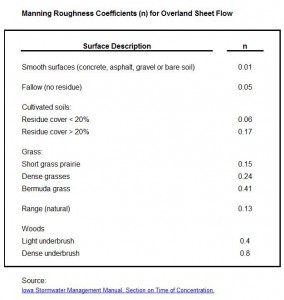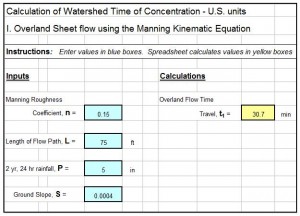Where to find Excel Spreadsheets for Watershed Time of Concentration
To obtain an Excel spreadsheet for watershed time of concentration calculations, click here to visit our spreadsheet store. Obtain a convenient, easy to use spreadsheet for watershed time of concentration calculation at a reasonable price. Read on for information about Excel spreadsheets that can be used for watershed time of concentration calculations.
The time of concentration for a watershed is the time for rainfall that lands on the farthest point of the watershed to reach the outlet. The main reason for interest in the watershed time of concentration is for its use as the storm duration in finding the design rainfall intensity to use in Rational Method calculation of peak storm water runoff rate.
The reason that the watershed time of concentration is used as design storm duration is because it gives the largest peak storm water runoff rate for a given return period. This can be reasoned out as follows: If the storm duration is less than the time of concentration, then the storm will end before runoff from the entire watershed reaches the outlet. Thus flow from the entire watershed will never all be contributing to the outflow. If the storm duration is greater than the time of concentration, then the storm will continue longer than it takes for the entire watershed to contribute to the outflow, but the storm intensity will be less for a storm of longer duration than one of short duration for a given return period. Thus the maximum peak storm water runoff rate for a specified return period on a given watershed will be for a storm with duration equal to the time of concentration of that watershed.
We can now move on to a discussion of how to calculate values for the time of concentration of a given watershed.
Methods for Estimating Watershed Time of Concentration
There are several empirical equations that have been developed for calculating travel time/time of concentration for different types and conditions of watersheds. Some examples are the Kerby equation, the Izzard equation, the Manning Kinematic equation, the Bransby Williams equation, the National Resources Conservation Service (NCRS) method, and the Manning equation. The following three equations will be discussed in this article: 1) the Manning Kinematic equation for use with overland sheet flow, 2) the NRCS method for shallow concentrated flow, and 3) the Manning equation for channel flow. These three methods are recommended by the U.S. Soil Conservation Service (SCS) in ref #1 at the end of this article. The Iowa Stormwater Management Manual (ref #2) also recommends these three methods. Typically overland sheet flow will occur in the upper portion of the watershed, followed by shallow concentrated flow, with channel flow for the final portion of watershed before the outlet.
Calculations with the Manning Kinematic Equation
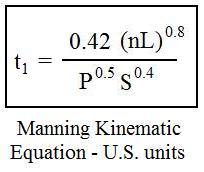 The boxes at the right show the Manning Kinematic equation for U.S. and for S.I. units. The parameters in the Manning Kinematic equation and their units are as follows:
The boxes at the right show the Manning Kinematic equation for U.S. and for S.I. units. The parameters in the Manning Kinematic equation and their units are as follows:
- t1 = overland sheet flow runoff travel time, min (NOTE: many places show the constant being 0.007 for U.S. units giving the time in hours. The equations in the boxes both give travel time in minutes.)
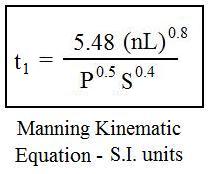
- n = Manning roughness coefficient, dimensionless*
- L = length of flow path, ft (S.I. – m)
- P = 2 year, 24 hr rainfall depth, in (S.I. – m)
- S = ground slope, ft/ft (S.I. m/m)
*See table of n values below.
The screenshot of an Excel spreadsheet template shown below will calculate overland sheet flow travel time with U.S. units using the Manning kinematic equation, based on the input values entered for the other parameters listed above. A tables with values of the Manning roughness coefficient for various overland flow conditions is also given below. This Excel spreadsheet and others for time of concentration calculations are available in either U.S. or S.I. units at a very low cost in our spreadsheet store.
Watershed Time of Concentration Calculations with the NRCS Method
The Manning Kinematic equation is recommended for travel length of no greater than 300 ft in ref #1 and for no greater than 100 ft in ref #2. Both of these references recommend use of the NCRS method for the shallow concentrated flow that normally develops within 100 to 300 ft into the watershed. The NCRS method calculates the velocity of the shallow concentrated flow first, based on the slope and the type of surface. The travel time is then calculated as travel length divided by velocity of flow. The equations used for the NRCS method are:
- t2 = L/(60V) ( for either U.S. or S.I. units )
- V = 16.1345 S0.5 for U.S. units ( V = 4.9178 S0.5 for S.I. units) for an unpaved surface
- V = 20.3282 S0.5 for U.S. units ( V = 6.1960 S0.5 for S.I. units) for a paved surface
An explanation of each of the parameters used in these equations follows:
- L is the length of the flow path in ft for U.S. or m for S.I. units
- V is the velocity of flow in ft/sec for U.S. or m/s for S.I. units
- S is the slope of the flow path, which is dimensionless for either U.S. or S.I. units
- t2 is the travel time for shallow concentrated flow in minutes (for either U.S. or S.I. units)
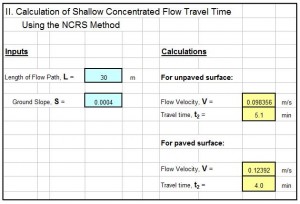 The screenshot of an Excel spreadsheet template shown at the left will calculate shallow concentrated flow travel time with S.I. units using the NRCS method, based on the input values indicated. This Excel spreadsheet and others for time of concentration calculations are available in either U.S. or S.I. units at a very low cost at www.engineeringexceltemplates.com or in our spreadsheet store.
The screenshot of an Excel spreadsheet template shown at the left will calculate shallow concentrated flow travel time with S.I. units using the NRCS method, based on the input values indicated. This Excel spreadsheet and others for time of concentration calculations are available in either U.S. or S.I. units at a very low cost at www.engineeringexceltemplates.com or in our spreadsheet store.
Calculation of Travel Time with the Manning Equation
The Manning equation is used for quite a variety of open channel flow calculations. It is recommended in ref#1 and ref #2 for any channel flow portion of the watershed runoff path. The following equations are used for Manning equation calculations:
- The Manning equation in U.S. units: Q = (1.49/n)A(R2/3)(S1/2)
- The Manning equation in S.I. units: Q = (1.0/n)A(R2/3)(S1/2)
- R = A/P
- V = Q/A
- t3 = L/(60V)
An explanation of the parameters in these equations and their U.S. and S.I. units follows:
- Q = channel flow rate in cfs for U.S. units or m3/s for S.I. units
- V = average velocity of flow in ft/sec for U.S. units or m/s for S.I. units
- R = hydraulic radius of the channel (= A/P) in ft for U.S. units or m for S.I. units
- A = channel cross-sectional area in ft2 for U.S. units or m2 for S.I. units
- P = wetted perimeter of channel in ft for U.S. units or m for S.I. units
- S = channel bottom slope, which is dimensioness for either set of units
- n = Manning roughness coefficient for channel
- L = length of flow path in ft for U.S. units or m for S.I. units
- t3 = travel time for channel flow in min for either set of units
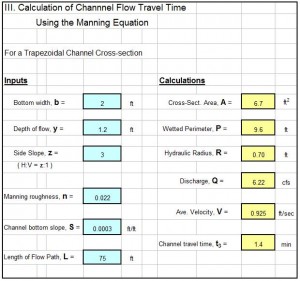 The screenshot of an Excel spreadsheet template shown at the right will calculate channel flow travel time with U.S. units using the NRCS method, based on the input values indicated. This Excel spreadsheet and others for time of concentration calculations are available in either U.S. or S.I. units at a very low cost at www.engineeringexceltemplates.com or in our spreadsheet store.
The screenshot of an Excel spreadsheet template shown at the right will calculate channel flow travel time with U.S. units using the NRCS method, based on the input values indicated. This Excel spreadsheet and others for time of concentration calculations are available in either U.S. or S.I. units at a very low cost at www.engineeringexceltemplates.com or in our spreadsheet store.
The overall time of concentration can now be calculated as the sum of t1, t2 and t3.
References:
1. U.S. Soil Conservation Service, Technical Note – Hydrology No N4, June 17, 1986.
2. Iowa Stormwater Management Manual, Section on Time of Concentration.
3. Knox County Tennessee Stormwater Management Manual, section on the Rational Method.
4.Bengtson, Harlan H., Hydraulic Design of Storm Sewers, Including the Use of Excel, an online, continuing education course for PDH credit.
5. Bengtson, Harlan H., “Spreadsheets for Rational Method Hydrological Calculations,” an Amazon Kindle e-book.

